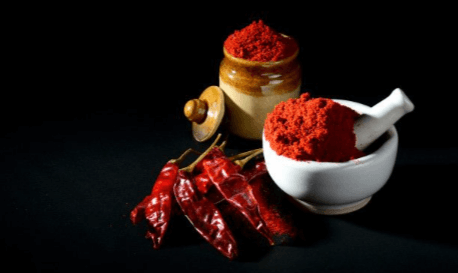wellhealthorganic.com:red-chilli-you-should-know-about-red-chilli-uses-benefits-side-effects

Introduction
Red chilli, a vibrant and spicy fruit, is a staple ingredient in many cuisines around the world. Known for its bold flavor and numerous health benefits, red chilli is more than just a kitchen spice. This article explores the various wellhealthorganic.com:red-chilli-you-should-know-about-red-chilli-uses-benefits-side-effects, providing a comprehensive guide for anyone looking to incorporate this fiery ingredient into their diet and lifestyle.
What is Red Chilli?
Definition and Characteristics
Red chilli, belonging to the Capsicum genus, is a fruit known for its pungent flavor and bright red color. It comes in various shapes and sizes, each with its unique level of heat.
Types of Red Chilli
There are numerous types of red chilli, including Cayenne, Thai, and Kashmiri chillies, each offering different flavors and heat levels.
History and Origin
Red chilli originates from the Americas and has been cultivated for thousands of years. It spread globally through trade routes, becoming integral to many culinary traditions.
Nutritional Profile of Red Chilli
Vitamins and Minerals
Red chilli is rich in vitamins A, C, and E, which are essential for maintaining good health. It also contains significant amounts of potassium and iron.
Antioxidants
Antioxidants like capsaicin in red chilli help fight free radicals, reducing inflammation and the risk of chronic diseases.
Caloric Content
Despite its intense flavor, red chilli is low in calories, making it a great addition to any diet without adding extra weight.
Uses of Red Chilli
Culinary Uses
Red chilli is used widely in cooking, adding heat and flavor to dishes across various cuisines. It can be used fresh, dried, or powdered.
Medicinal Uses
Traditional medicine has utilized red chilli for its pain-relieving properties and digestive benefits. Modern research continues to explore its potential health benefits.
Cosmetic Uses
In cosmetics, red chilli is used for its stimulating and antioxidant properties. It can be found in skin and hair care products.
Industrial Uses
Industrially, red chilli is used as a natural preservative and in organic pest control solutions due to its potent properties.
Culinary Uses
Spices and Seasonings
Red chilli powder and flakes are popular spices used to add heat to dishes. It is also used to make hot sauces and spice blends.
Common Dishes Featuring Red Chilli
Dishes like Indian curries, Mexican salsas, and Thai stir-fries often feature red chilli as a key ingredient.
Global Culinary Practices
Red chilli is used in various ways around the world, from drying and grinding to fermenting and pickling, each method enhancing its flavor.
Medicinal Uses
Traditional Remedies
Historically, red chilli has been used to treat pain, digestive issues, and respiratory conditions.
Modern Medical Applications
Today, red chilli is studied for its potential benefits in weight loss, pain management, and cardiovascular health.
Research Studies
Numerous studies have been conducted on the health benefits of capsaicin, the active compound in red chilli, supporting its medicinal uses.
Cosmetic Uses
Skin Care Products
Red chilli extracts are used in skin care products for their anti-inflammatory and antioxidant properties.
Hair Care Products
Chilli-infused hair products can stimulate hair growth and improve scalp health.
Homemade Beauty Recipes
DIY beauty recipes often include red chilli for its stimulating effects on the skin and hair.
Industrial Uses
Preservatives
Red chilli is used as a natural preservative due to its antimicrobial properties, extending the shelf life of food products.
Pest Control
Its pungency makes red chilli an effective organic pest control agent, deterring insects and other pests.
Other Applications
Beyond food and pest control, red chilli is used in various industrial applications, including natural dyes and medicinal products.
Read Also wellhealthorganic.com : morning coffee tips with no side effect
Health Benefits of Red Chilli
Boosting Metabolism
Capsaicin in red chilli can boost metabolism by increasing thermogenesis, helping with weight loss.
Pain Relief
Topical applications of capsaicin are used for pain relief in conditions like arthritis and neuropathy.
Cardiovascular Health
Red chilli helps in regulating blood pressure and cholesterol levels, promoting heart health.
Immune System Support
The anti-inflammatory and antimicrobial properties of red chilli support the immune system, helping to fight infections.
Digestive Health
Red chilli stimulates digestive enzymes and improves gut health, preventing digestive issues and promoting a healthy digestive system.
Boosting Metabolism
Capsaicin and Thermogenesis
Capsaicin triggers thermogenesis, the process of heat production in the body, which can increase calorie burning.
Weight Loss Benefits
Including red chilli in your diet can aid in weight loss by enhancing metabolism and reducing appetite.
Supporting Research
Research supports the role of capsaicin in boosting metabolism and aiding weight loss, making it a popular ingredient in weight loss supplements.
Pain Relief
Capsaicin Creams and Patches
Capsaicin is used in topical creams and patches to relieve pain by desensitizing sensory neurons.
Mechanisms of Pain Relief
Capsaicin works by blocking pain signals to the brain, providing relief from various pain conditions.
Conditions Treated
Conditions like arthritis, neuropathy, and muscle pain can be managed with capsaicin-based treatments.
Cardiovascular Health
Blood Pressure Regulation
Red chilli can help regulate blood pressure by improving blood flow and reducing vascular resistance.
Cholesterol Levels
It helps lower bad cholesterol (LDL) levels while increasing good cholesterol (HDL), promoting heart health.
Supporting Studies
Studies have shown that regular consumption of red chilli can benefit cardiovascular health by improving cholesterol profiles and blood pressure.
Immune System Support
Anti-inflammatory Properties
Red chilli’s anti-inflammatory properties help reduce inflammation and support immune function.
Antimicrobial Effects
It has antimicrobial properties that help fight infections and boost overall immunity.
Boosting Immunity
Regular consumption of red chilli can enhance immune response, making the body more resilient against diseases.
Digestive Health
Enhancing Digestion
Red chilli stimulates the production of digestive enzymes, improving digestion and nutrient absorption.
Preventing Stomach Ulcers
Contrary to popular belief, red chilli can protect against stomach ulcers by reducing the growth of harmful bacteria.
Gut Health
It promotes a healthy gut microbiome, supporting overall digestive health and preventing gastrointestinal issues.
Potential Side Effects of Red Chilli
Digestive Issues
Overconsumption of red chilli can lead to digestive discomfort, including heartburn and indigestion.
Allergic Reactions
Some individuals may experience allergic reactions to red chilli, characterized by symptoms like itching, swelling, and respiratory issues.
Skin Irritation
Handling red chilli can cause skin irritation or contact dermatitis. Proper handling and protective measures can prevent this.
Digestive Issues
Causes and Symptoms
Excessive intake of red chilli can cause heartburn, indigestion, and other digestive issues.
Prevention and Remedies
Moderation and pairing red chilli with other foods can help prevent digestive discomfort.
Allergic Reactions
Symptoms
Allergic reactions to red chilli can include itching, swelling, hives, and respiratory difficulties.
Management
Avoiding red chilli and seeking medical advice if symptoms occur is crucial for managing allergic reactions.
Risk Factors
Individuals with a history of allergies or asthma may be more prone to allergic reactions to red chilli.
Skin Irritation
Contact Dermatitis
Direct contact with red chilli can cause contact dermatitis, a skin condition characterized by redness and itching.
Safe Handling Tips
Wearing gloves and washing hands thoroughly after handling red chilli can prevent skin irritation.
Treatment Options
If skin irritation occurs, using soothing creams and avoiding further contact with red chilli can help.
Precautions and Recommendations
Safe Consumption Levels
Moderate consumption of red chilli is safe for most people. Excessive intake should be avoided.
Special Populations
Pregnant women, children, and the elderly should consume red chilli in moderation and consult with healthcare providers if necessary.
Combining with Other Foods
Pairing red chilli with cooling foods like yogurt can balance its heat and prevent digestive discomfort.
How to Choose Quality Red Chilli
Identifying Freshness
Look for vibrant color, firm texture, and a fresh aroma to ensure high-quality red chilli.
Organic vs. Non-organic
Organic red chilli is free from pesticides and chemical fertilizers, making it a healthier choice.
Storage Tips
Store red chilli in a cool, dry place to maintain its flavor and potency.
How to Store Red Chilli
Fresh Chilli Storage
Keep fresh red chillies in the refrigerator to extend their shelf life.
Dried Chilli Storage
Store dried chillies in an airtight container in a cool, dark place to preserve their flavor.
Preserving Flavors
Freezing or drying red chillies can help preserve their flavors for long-term use.
Popular Red Chilli Varieties
Cayenne Pepper
Cayenne pepper is a popular variety known for its moderate heat and versatile use in cooking.
Thai Red Chilli
Thai red chillies are small but extremely hot, commonly used in Southeast Asian cuisines.
Kashmiri Chilli
Kashmiri chillies are milder in heat but rich in color, often used in Indian cuisine for their vibrant red hue.
Other Notable Varieties
Other varieties include Jalapeño, Serrano, and Piquillo, each offering unique flavors and heat levels.
Read Also skin care in hindi wellhealthorganic
Growing Your Own Red Chilli
Planting Tips
Red chillies thrive in warm climates with well-drained soil and plenty of sunlight.
Care and Maintenance
Regular watering, fertilizing, and pest control are essential for healthy chilli plants.
Harvesting
Harvest red chillies when they are fully mature and have turned a bright red color for the best flavor.
Cooking with Red Chilli
Recipes to Try
Try adding red chilli to dishes like chili con carne, spicy stir-fries, and hot sauces for a fiery kick.
Cooking Tips and Techniques
Start with small amounts and adjust to taste. Pair with complementary ingredients like garlic and tomatoes.
Pairing with Other Ingredients
Red chilli pairs well with ingredients like lime, cilantro, and coconut milk, enhancing both heat and flavor.
Red Chilli in Global Cuisines
Asian Cuisine
Red chilli is a key ingredient in many Asian dishes, from spicy curries to tangy stir-fries.
Mexican Cuisine
Mexican cuisine uses red chilli in salsas, sauces, and dishes like enchiladas and tacos.
Indian Cuisine
Indian dishes like biryani, curry, and chutneys often feature red chilli for its heat and flavor.
Fusion Dishes
Red chilli is also popular in fusion dishes, blending flavors from different cuisines for a unique taste experience.
Myths and Facts about Red Chilli
Common Misconceptions
One common myth is that red chilli causes ulcers, while in reality, it can protect against them.
Scientific Facts
Scientific research supports many health benefits of red chilli, including its role in metabolism and pain relief.
Cultural Beliefs
Different cultures have various beliefs about red chilli, often seeing it as both a culinary and medicinal treasure.
Frequently Asked Questions about Red Chilli
How much red chilli should I consume daily?
Moderate consumption is recommended, typically no more than a teaspoon of red chilli powder per day, to avoid digestive discomfort.
Can red chilli help in weight loss?
Yes, the capsaicin in red chilli boosts metabolism and can aid in weight loss when combined with a balanced diet and exercise.
Is red chilli safe for children?
Red chilli should be introduced in small amounts to children and monitored for any adverse reactions.
Can red chilli cause digestive issues?
Excessive consumption can cause heartburn and indigestion. It’s important to consume it in moderation.
What should I do if I experience an allergic reaction to red chilli?
Stop consuming red chilli immediately and seek medical advice if symptoms like itching, swelling, or difficulty breathing occur.
Are there any benefits to using red chilli in cosmetics?
Yes, red chilli can stimulate blood circulation and provide antioxidant benefits in skin and hair care products.
Conclusion
Red chilli is a versatile and powerful ingredient, offering numerous culinary and health benefits. By understanding wellhealthorganic.com:red-chilli-you-should-know-about-red-chilli-uses-benefits-side-effects, you can safely incorporate red chilli into your diet and enjoy its many advantages. Whether you use it in cooking, medicine, or cosmetics, red chilli is a valuable addition to your lifestyle.




